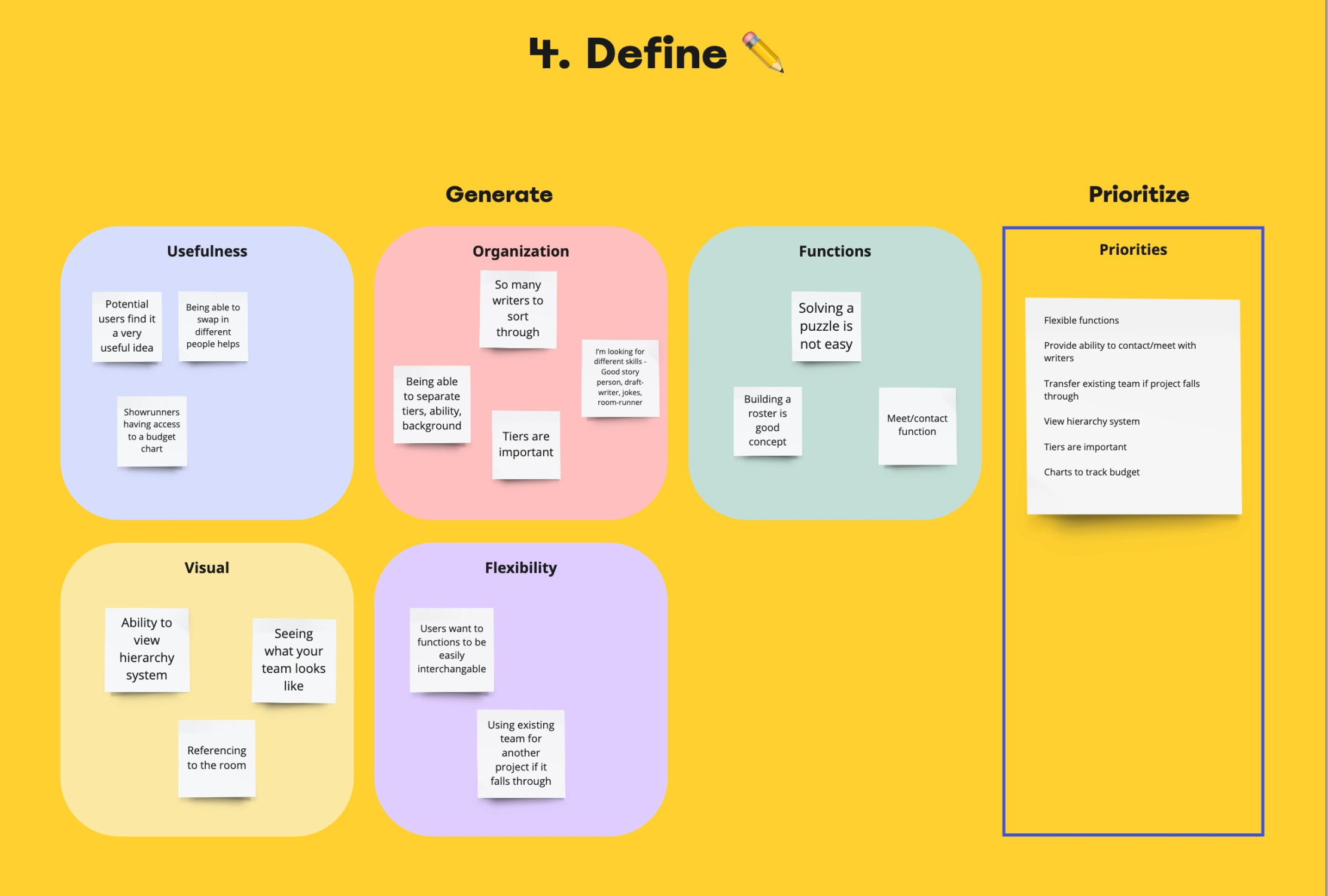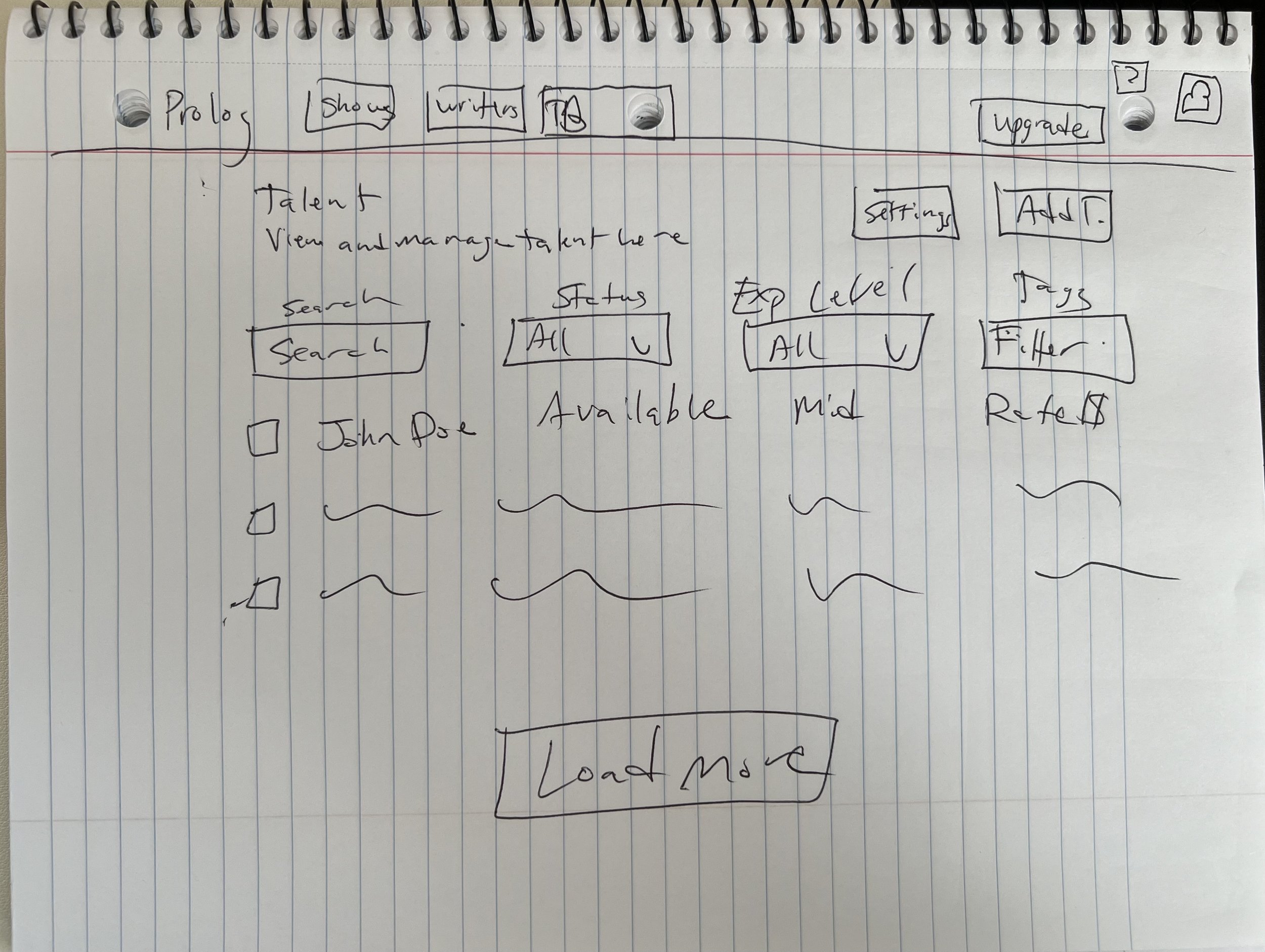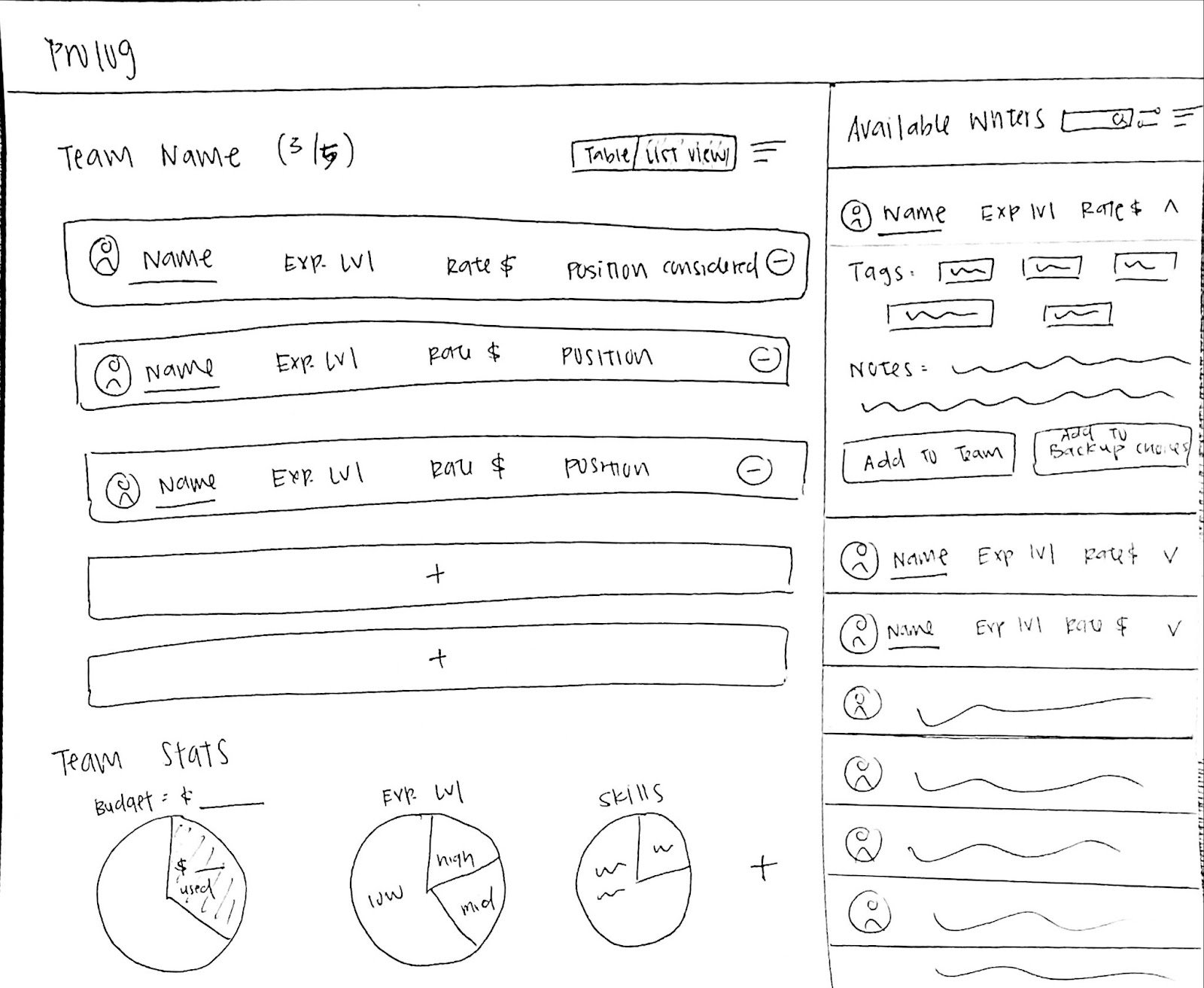
Prolog
Team Builder
The Client:
🎬Prolog🎭
Prolog is a Hollywood startup that provides showrunners to operate on a singular platform to optimize their creative process in television production, development and the writer’s room. It eliminates outdated and user unfriendly software that hinders the show creation process. It houses all the necessary functions showrunners need to successfully put collaborate on a show with writers, the studio, and other contributors.
I spent about eight weeks working on Team Builder as the lead on a three-person team. I want to state how amazing this experience was to work for a start-up company and we got to collaborate with CEO Jon Stahl, which was career-changing opportunity.
🧑🏻🎨Role👨🏿🔧
Team Lead
•
Manager
•
Researcher
•
Writer
•
UI Design
•
Team Lead • Manager • Researcher • Writer • UI Design •
🚩Assumption of a Problem🚩
Lack of service that can efficiently arrange a writing team is causing user to lose time from putting a show together. Having to use software not meant organize Hollywood writing staff teams can get inefficient. Not able to view the writing room can get frustrating
👩🏾🔬Secondary Research🔬
Running a show is a tall task to begin with. Being able to cut down on time and stress in an area will help showrunners produce shows more effectively and efficiently.
Prolog and Jon conducted interviews prior to our team coming on and they provided us the videos and documents that provided us information on how users felt about a possible roster building or team building function built into Prolog.
🤼Competitor Analysis👟
Currently, there’s only one service that is somewhat similar to Prolog and it’s called Writers Room Pro. Writers Room Pro offers a platform to collaborate with your team of writers and isn’t quite in-depth as Prolog. Writers Room Pro also doesn’t offer Team Builder but this is closest to a competitor to Prolog.
What Writers Room Pro does not offer is Team Builder. Users need a way to organize and filter writers that are sent in from agencies, studios, executives, and even their list of writers. There are a lot of different criteria that go into staffing a team of writers including budgetary concerns, scheduling conflicts, and more. The idea is to create a team building system so staffing a team of writers is more efficient and users can create different iterations of teams that best meet their criteria.
📊Heuristic Competitor Analysis📈
I conducted heuristic competitor analysis with Writers Room Pro. We’ll be looking at the visibility of system status, match between system and the real world, and the aesthetic and minimalist design. The heuristic competitor analysis comes from the Nielsen Norman Group’s 10 Usability Heuristics for User Interface Design.
The rating system will range from a scale from 1 to 5.
1 = Extremely Poor
2 = Poor but shows room for improvement
3 = Mediocre, average
4 = Good, could improve some areas
5 = Great, little flaws
🕵🏼♀️Insights🕵🏻♂️
Visibility of System Status:
Rating: 4
Evaluation:
The functions of Writers Room Pro allow collaboration, which it's designed to do. The pages are in need of a redesign as colors are dull, however the function of the service does what it says it does. There’s a lot of information on the site that explains clearly what their service entails.
Match Between System and the Real World:
Rating: 3
Evaluation:
There’s a lot of information on Writers Room Pro. The image below is information that is very helpful and it offers a summary of its services. However, the rest of the homepage goes through quotes from users, fuzzy mockups of the functions and services, and a lot of unnecessary information that has already been explained.
Aesthetic and Minimalist Design:
Rating: 3
Evaluation:
There’s a lot of information to digest on the homepage of Writers Room Pro and the design of the services is not aesthetically appealing.
📍Affinity Map🗺️
-
Why?
To make sense of all of that date collected from interviews conducted by Jon Stahl and the Prolog team
-
What was the result?
We created an affinity board put a visual together for all the data Prolog gathered from their interviews
-
Insights
We found users have a lot on their plate and need a system that can help organize what they need, sort through writers they’re looking at, have a way to contact and meet with writers and be able to view their team as a room and through hierarchy positions




🧍🏾♀️Personas🧍🏻♂️
We created personas to put together a realistic representation of our key user base.
Results:
We were able to flesh out three different types of users Team Builder will be encountering based off the secondary research. We have a good look at how Team Builder should be designed.
Insights:
Team Builder will be used by writers who will be staffing their own team. Most are experienced producers and writers in Hollywood. Some are not technologically savvy so Team Builder will need to be simple but also effective and efficient. Clutter will need to be at a minimum. Also, Team Builder will need to be flexible with filters and the number of teams that users can create because there are a lot of outside variables that go into staffing a team of writers for a show.
🤔How Might We🧐
Problem: Putting together a writing staff can be a long and messy process. We wanted to
Support
How might we support users to efficiently put together a writing staff
Simplify
How might we simplify organizing a staff of writers
Budget
How might we set a budget for writers and have the budget go up and down as you add more writers to your team
Efficiency
How might we make choosing the writing team quick and intuitive
Information
How might we provide users with all the information on writers they want/need
Accuracy
How might we ensure users have an accurate visualization of their perfect team
📖User Story📘
Why:
We created a user story to define our user’s journey, from beginning to end, of how they would be using the product. This helps us pinpoint what we need as a starting point to create our MVP.
Results:
The results were pretty complex. Even though our goal was to create a site that required the minimal amount of steps for the user to complete their journey, there were more steps that were required than expected.
Insights:
Through our user story, we were able to map out the requirements needed for our MVP. It painted a picture from the user’s perspective that helped us determine how we should implement it into the design flows.
👤User Flow🚣
We created several use case scenarios with our user flows. The first thing we wanted to make sure was to get the team creation down. As we were going through the research process, we had the idea of selecting candidates through Team Builder. As we moved on in the ideation process we determined candidates were pre-selected in a different part of the website so our user flow changed.
This is our first iteration of Team Builder. Like we mentioned, we had a different idea of how candidates were filtered into Team Builder initially.
As we mentioned during our first iteration, we accounted for a filtering process and the user flow for that process is below.
We needed a way to remove writers from a team so that process is below.
And finally, we put together our last iteration of the team creation page without the filtering process.
✏️Sketches✏️
We came up with a lot of potential screens that Team Builder could look at and gave us a good idea on how we want Team Builder to look like. Having sketches to work with gave us a foundation for Team Builder. It laid out how we want things to look and where we would place certain features.
👨💻Wireframes:📲
Why:
We’re creating wireframes to build upon the foundation of Team Builder. We took inspiration from our sketches and created an efficient and simple to make it user friendly for show runners who are not experienced with technology and who want to maximize their time.
Results:
We came up with something that isn’t overly complicated and that’s user friendly. The less amount of prompts and screens users go through, less errors and pain points users face while using Team Builder. We wanted to make sure a team creation page was present at the beginning of Team Builder and an option to add collaborators was crucial. An empty state was important to demonstrate how the site looked without taking any actions. Two driving points was the ability to toggle between a list view and a table view, which was requested by a good number of potential users. The selection process was key, along with an ultra-filtering process. We wanted to make sure users had a chance to filter writers down more within Team Builder.
Insights:
The Team Builder idea isn’t an overly complicated process however it took multiple iterations to hammer down how we wanted it to function. There still needs to be more iterations done but keeping the screens and actions easy was something we wanted to hammer home. In the next ideation, we’ll need to incorporate how the tables will work. The Budget is a major part of team creation.
📚Learning:
😮💨🎉🥳
I really learned a lot from Prolog and working on Team Builder. It gave me a sense of how start-up companies work and how design decisions are made. It also opened my eyes to being more fluid with the design process rather than following the steps how we were taught.































